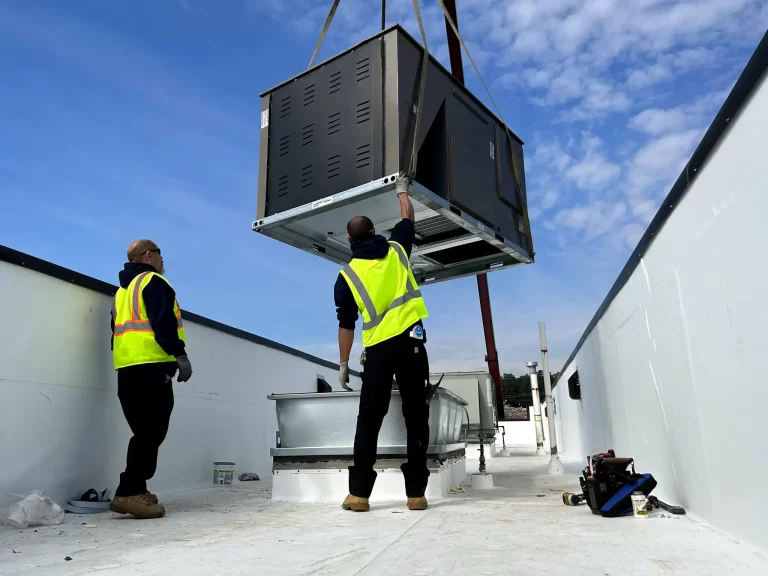With the average person spending about 90% of their time indoors, indoor air quality has become an essential concern. Poor indoor air quality can have negative effects on your health and well-being. In Arlington, where the weather can range from extreme heat to cold winters, it’s crucial to ensure that your indoor air quality is at its best. In this article, we will explore the importance of good indoor air quality, common indoor air pollutants in Arlington, various methods to assess and improve your indoor air quality, and the role of plants in purifying the air.
Understanding Indoor Air Quality
Indoor air quality refers to the quality of the air inside buildings and structures. It encompasses various factors such as the presence of pollutants, humidity levels, and proper ventilation. Understanding these factors is the first step in creating a healthier living environment for you and your family.
When it comes to indoor air quality, there is more than meets the eye. It’s not just about the air we breathe; it’s about the impact it can have on our health and well-being. Poor indoor air quality can lead to a wide range of health problems, including respiratory issues, allergies, and even more severe conditions. That’s why it’s essential to take steps to improve the air quality in our homes.
The Importance of Good Indoor Air Quality
Good indoor air quality is crucial for overall health and well-being. It goes beyond just providing a comfortable living space; it can directly impact our physical and mental health. When we breathe in clean air, our bodies can function optimally, and we are less likely to experience respiratory problems or allergies.
On the other hand, poor air quality can have a detrimental effect on our health. It can lead to the development or exacerbation of respiratory conditions such as asthma or chronic obstructive pulmonary disease (COPD). Additionally, it can trigger allergies, causing symptoms like sneezing, coughing, and itchy eyes.
Moreover, studies have shown that long-term exposure to indoor air pollutants can increase the risk of more severe health conditions, including heart disease and certain types of cancer. This highlights the importance of taking proactive measures to improve the air quality in our homes.
Common Indoor Air Pollutants in Arlington
There are several common indoor air pollutants that can negatively impact your health in Arlington. These pollutants include dust, pet dander, pollen, mold spores, volatile organic compounds (VOCs) from household products, and even outdoor pollutants that find their way indoors. Understanding what these pollutants are and how to reduce their presence is crucial for improving your indoor air quality.
Dust is a common indoor air pollutant that consists of tiny particles from various sources, such as skin cells, pet hair, and fibers from fabrics. Breathing in dust can trigger allergies and respiratory problems, especially for individuals with pre-existing conditions.
Pet dander, another common indoor air pollutant, refers to the tiny flecks of skin shed by animals. These allergens can cause allergic reactions in sensitive individuals, leading to symptoms like sneezing, itching, and congestion.
Pollen is another significant indoor air pollutant, especially during allergy seasons. It can enter our homes through open windows or be carried indoors on our clothes. Breathing in pollen can trigger allergic reactions, causing discomfort and respiratory issues.
Mold spores are a type of fungus that can grow in damp and poorly ventilated areas of our homes. When mold spores become airborne, they can be inhaled, leading to respiratory problems and allergic reactions. It’s crucial to address any mold issues promptly to prevent further health complications.
Volatile organic compounds (VOCs) are chemicals that can be found in various household products, including cleaning supplies, paints, and furniture. These compounds can be released into the air, leading to poor indoor air quality. Prolonged exposure to VOCs can cause headaches, dizziness, and even long-term health effects.
Lastly, outdoor pollutants can find their way indoors through open windows, doors, or cracks in the building. These pollutants include vehicle emissions, industrial pollutants, and allergens from plants and trees. While we may not have control over outdoor air quality, we can take steps to minimize the entry of these pollutants into our homes.
Improving indoor air quality involves a combination of strategies, including proper ventilation, regular cleaning, and the use of air purifiers. By understanding the common indoor air pollutants in Arlington and taking proactive measures to reduce their presence, you can create a healthier and more comfortable living environment for yourself and your loved ones.
Assessing Your Indoor Air Quality
Before you can make improvements to your indoor air quality, it’s essential to assess the current state of the air in your home. There are various methods and signs that can indicate when your indoor air quality is poor.
Signs of Poor Indoor Air Quality
Signs of poor indoor air quality include persistent coughing, sneezing, itchy eyes, fatigue, and headaches. If you or your family members experience these symptoms regularly, it may be an indication that your indoor air quality needs attention.
Professional Indoor Air Quality Testing
If you suspect that your indoor air quality is poor or want a more comprehensive assessment, it may be worth considering professional indoor air quality testing. These tests can identify specific pollutants and provide recommendations on how to improve your air quality effectively.
Improving Indoor Air Quality in Arlington
Now that you have a better understanding of indoor air quality and how to assess it, let’s explore some effective ways to improve your indoor air quality in Arlington.
Air Purification Systems
Air purification systems can significantly improve your indoor air quality by removing pollutants, allergens, and other particles from the air. These systems come in various types, such as HEPA filters, ionizers, and UV light purification. Depending on your specific needs and budget, you can choose a system that suits your requirements.
Humidity Control Solutions
Arlington’s weather can be humid, especially during the summer months. Controlling humidity levels is essential for preventing mold growth and maintaining a comfortable living environment. Consider investing in a dehumidifier or humidifier to regulate humidity levels and improve your indoor air quality.
Ventilation Improvements
Proper ventilation is crucial for maintaining good indoor air quality. Poorly ventilated spaces can trap indoor pollutants and reduce air circulation. Ensure that your home has sufficient ventilation by regularly opening windows, using exhaust fans in kitchens and bathrooms, and considering the installation of an energy recovery ventilator.
Maintenance for Optimal Indoor Air Quality
Maintaining your HVAC system and following proper maintenance routines is essential for optimal indoor air quality.
Regular HVAC System Cleaning
Regular cleaning and maintenance of your HVAC system can prevent the accumulation of dust, allergens, and other pollutants. Clean or replace your air filters regularly, schedule professional HVAC maintenance at least once a year, and ensure that your air ducts are clean and free from debris.
Importance of Air Filter Replacement
Replacing air filters regularly is crucial for maintaining good indoor air quality. Dirty or clogged filters can impede proper filtration and lead to reduced air quality. Consult your HVAC system’s manual or a professional to determine the appropriate frequency for filter replacements.
The Role of Plants in Improving Indoor Air Quality
In addition to the methods mentioned above, incorporating indoor plants into your home can significantly improve your indoor air quality. Certain plants have air-purifying properties and can help remove toxins from the air.
Best Indoor Plants for Air Purification
Some of the best indoor plants for air purification include snake plants, peace lilies, spider plants, and pothos. These plants are not only aesthetically pleasing but also effective in removing pollutants and enhancing your indoor air quality.
By understanding the importance of good indoor air quality, assessing and improving your current air quality, and incorporating methods such as air purification systems and plant care, you can create a healthier and more enjoyable living environment in Arlington. Don’t overlook the significance of indoor air quality for your overall well-being.


